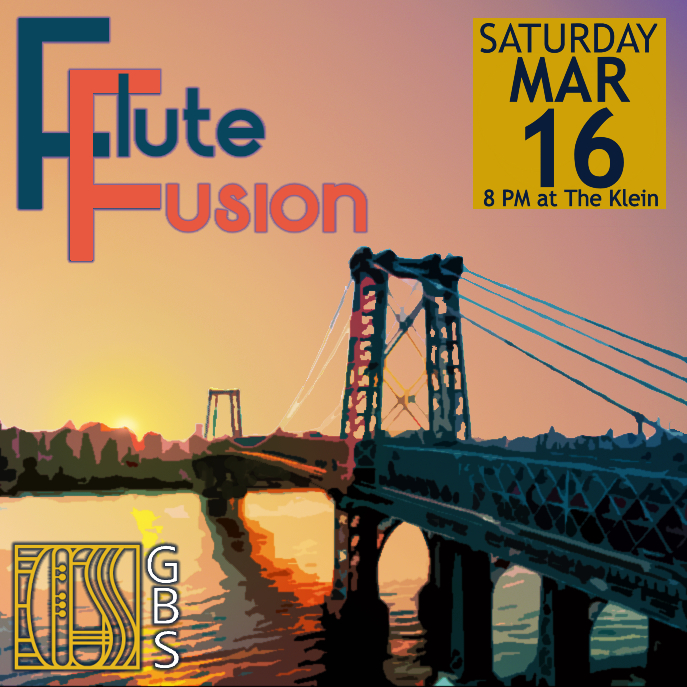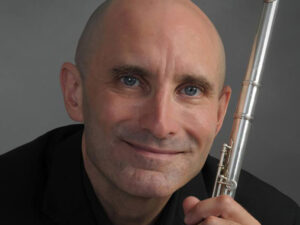
- This event has passed.
Flute Fusion
March 16, 2024 @ 8:00 pm


The flute figures prominently with solos by GBS’ own Grammy® nominated Principal Flautist, Keith Bonner. Debussy’s ethereal Afternoon of a Faun, Paul Schoenfeld’s Klezmer Rondos, and African-American composer Jessie Montgomery’s Coincident Dances surround Schubert’s Symphony No. 5. Not “The Magic Flute,” but a whole night of the magic of the flute!
The March 16 concert is sponsored by the family of Jennifer C. Moorin, who passed away in January. Along with her husband, retired local attorney Herbert Moorin (a longtime Trustee of GBS), Jennifer was a prominent supporter and ardent worker in many local charities. “Jennifer was a bright light at GBS for decades,” says GBS Chairman of the Board Doris Harrington.” “We are saddened by her loss but know that her spirit is well-expressed in Schubert’s Symphony No. 5, we’ll be dedicating and performing in her honor in March.”
Program Notes
March 16, 2024
—Frank Martignetti, PhD.
Sacred Heart University
Debussy: l’Après Midi d’un Faune
Jessie Montgomery: Coincident Dances
Paul Schoenfeld: Klezmer Rondos
Schubert: Symphony #5
Our program opens with a piece written in 1894 that transformed music history forever: Claude Debussy’s Prélude à l’après-midi d’un faune (L. 86). This ten-minute Impressionist masterpiece is viewed as a turning point in music history; Pierre Boulez memorably stated that “the flute of the faun brought new breath to the art of music.” Debussy was inspired by the poem of the same name by the French symbolist Stéphane Mallarmé. Symbolist poets resisted naturalism and realism, and sought to write about spirituality, the subconscious, imagination, and dreams. Charles Burkhardt tells us that:
[This prelude] was [Debussy’s] musical response to the poem of Stephane Mallarmé (1842–1898), in which a faun playing his pan-pipes alone in the woods becomes aroused by passing nymphs and naiads, pursues them unsuccessfully, then wearily abandons himself to a sleep filled with visions. Though called a “prelude,” the work is nevertheless complete – an evocation of the feelings of the poem as a whole.
You will be struck by the dreamlike, hazy nature of the Prelude. The piece begins with a languid flute solo, centered on the tritone: the powerful and unstable interval that was viewed as “the devil in music” in the Renaissance, but that forms the powerful gravitational pull of the dominant seventh chord, and has given us the opening notes of Leonard Bernstein’s immortal “Maria.” The rhythm and the tonality of the piece are fluid, and ever shifting. The tonal ambiguity leads to the whole tone scale, a major characteristic of Impressionism. This whole tone scale floats freely, lacking the gravitational pull of the major or minor scale.
It is interesting to note the careful compositional structure that Debussy used to create the dreamworld of the Prelude; I’ll unpack this with you in the pre-concert lecture. Debussy uses compact musical ideas, called “cells” (motives) and builds the piece systematically from them. It’s fascinating to note that the piece is 110 measures long, and, while the piece of music is not a linear narrative, Mallarmé’s poem is also 110 lines long.
Both of our next two pieces juxtapose multiple musical styles to evoke a place or occasion, in ways similar to George Gershwin’s work in Rhapsody in Blue and An American in Paris.
Composer Jesse Montgomery has this to share regarding her Coincident Dances, which I’m looking forward to experiencing with you for the first time at this concert. The GBS is one of the first fifteen orchestras in the world to perform this new work. Says Montgomery:
Coincident Dances is inspired by the sounds found in New York’s various cultures, capturing the frenetic energy and multicultural aural palette one hears even in a short walk through a New York City neighborhood. The work is a fusion of several different sound-worlds: English consort, samba, mbira dance music from Ghana, swing, and techno.
My reason for choosing these styles sometimes stemmed from an actual experience of accidentally hearing a pair simultaneously, which happens most days of the week walking down the streets of New York, or one time when I heard a parked car playing Latin jazz while I had rhythm and blues in my headphones. Some of the pairings are merely experiments. Working in this mode, the orchestra takes on the role of a DJ of a multicultural dance track.
Klezmer Rondos evokes typical Eastern European klezmer band sounds within a typical concert work, characteristic of Schoenfeld’s amalgamation of differing styles. Somewhat uniquely in the orchestral repertoire, this piece includes saxophones and coronet (the trumpet-like instrument played by Louis Armstrong.) While we tend to think of the clarinet as the characteristic solo instrument in klezmer, the flute, violin or trumpet took on this role as well. Our own principal flutist, Keith Bonner, takes the lead on flute and piccolo. I’m indebted to Neil Levin for this context:
Klezmer Rondos quotes directly the opening section of a song of the Lubavitcher Hassidim, Kol dodi (Voice of My Beloved), from Song of Songs, attributed to the first Lubavitcher—or ḥabad—rebbe, Rabbi Shneier Zalman of Liady. A variation is often attributed to rebbes of different dynasties who were Rabbi Zalman’s contemporaries. There is also the quotation of a well-known Lubavitcher niggun rikkud (dance tune), as well as other typical idiomatic Hassidic phrases and inflections throughout…An original Yiddish song in folk style, to the poem Mirele by Michl Virt, concludes the first of the two movements.
Schubert’s Symphony No. 5 uses the smallest orchestra of his symphonies; Schubert seems to have been particularly enamored with Mozart when writing this symphony, and the instrumentation matches the first version of Mozart’s Symphony No. 40. The first movement is Schubert’s first to not begin slowly, but begins with a very simple rising arpeggio (do-mi-sol) that comprises the first theme. Unusually, the recapitulation begins in Eb (IV), not Bb—a device Schubert had used before. The second, slow movement ranges far afield harmonically, in a way characteristic of Schubert but not heard in Haydn, Mozart, or Beethoven. The third movement, a minuet, is extremely Mozartean in character and harmony. The symphony concludes with a finale that is the shortest of the four movements.
Click here then click “Subscriptions” for subscriptions at deep discounts.